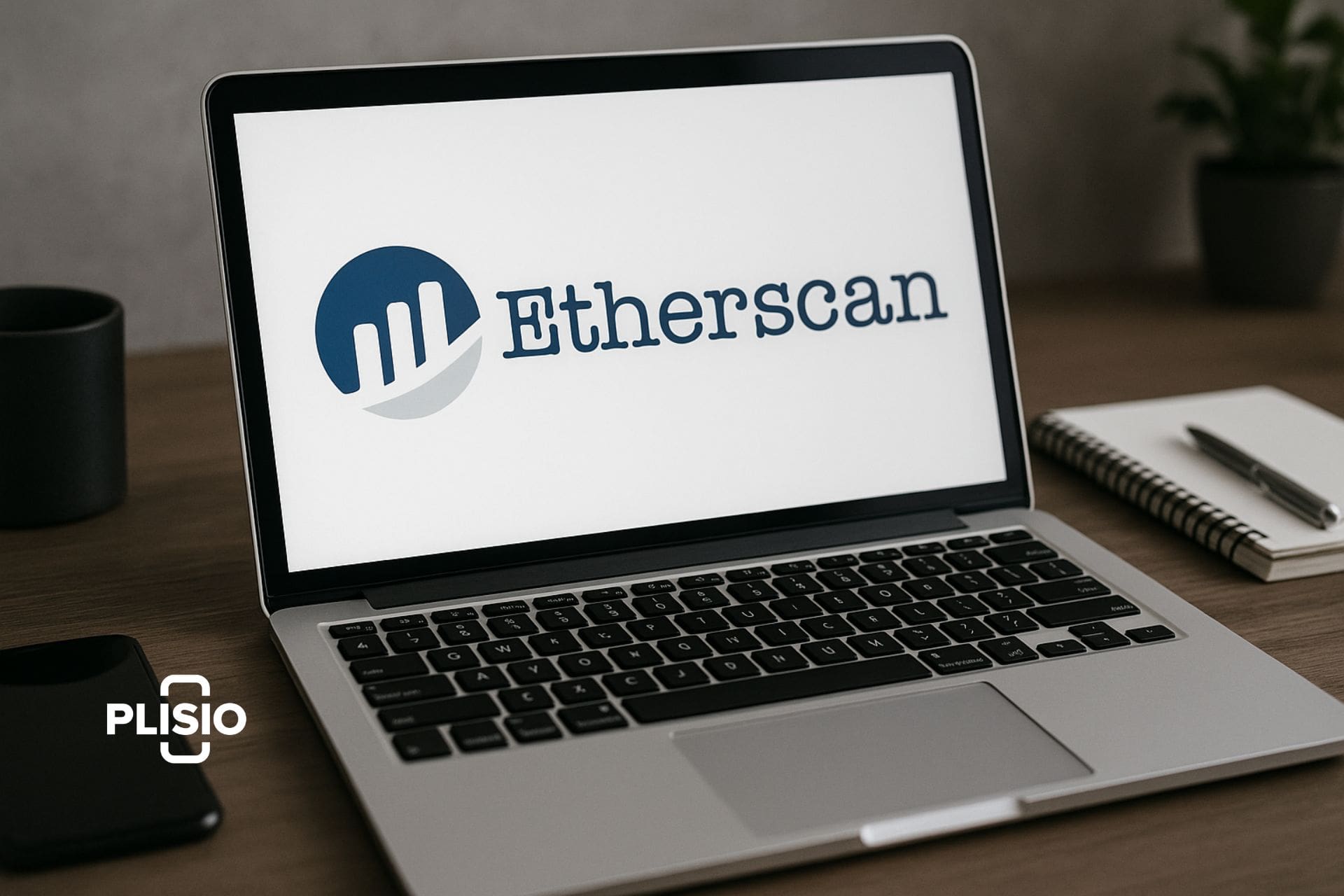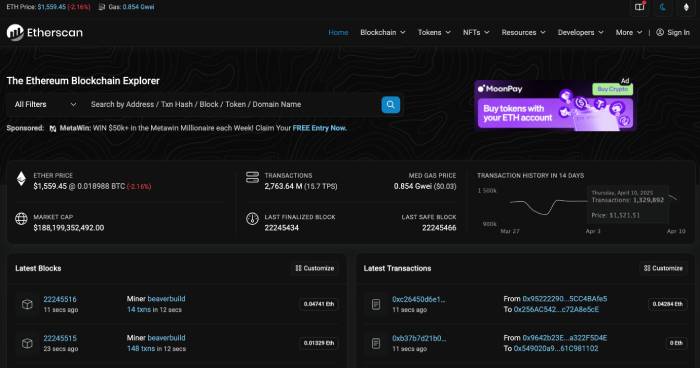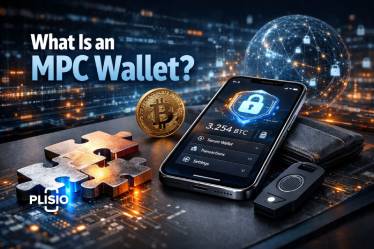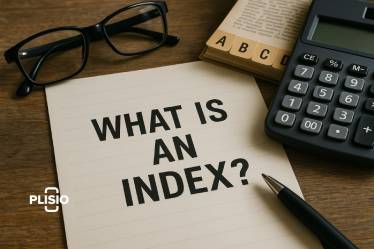Etherscan

This platform offers an intuitive and powerful gateway to understanding Ethereum transactions and smart contracts, providing a panoramic view of the network's activities.
Understanding blockchain transactions and data is crucial for anyone aiming to deepen their knowledge of cryptocurrencies, NFTs, and decentralized applications (dApps). Blockchain's transparent public ledger stores all transaction data, yet accessing and interpreting this wealth of information can be daunting without the right tools.
Block explorers are essential for navigating these complex waters, and Etherscan emerges as the premier choice for the Ethereum blockchain, which hosts the largest array of dApps. Mastering Etherscan not only equips users to traverse the Ethereum landscape but also provides a framework for understanding other blockchains.
Etherscan is a favorite among on-chain investigators and blockchain enthusiasts, offering insights and tools crucial for navigating the Ethereum ecosystem. In this guide, we delve into what Etherscan is, how it operates, and how you can leverage its capabilities to enhance your understanding of the Ethereum network.
Let’s embark on this exploratory journey together.
What is Etherscan?
Etherscan, launched in 2015 by a dedicated team of blockchain enthusiasts, stands as a cornerstone block explorer and analytics platform for the Ethereum network. Designed with the user in mind, it serves as a comprehensive window into the Ethereum blockchain, allowing for the easy navigation, verification, and exploration of transactions, addresses, and smart contracts.
This platform transcends the basic functionality of a block explorer, offering insights into a wide spectrum of Ethereum activities. From tracking ERC-20 token transactions and NFT mints to delving into smart contract details and monitoring wallet balances, Etherscan makes these complex tasks accessible and straightforward.
Much like how search engines such as Google, or Bing index and render the vast data of the internet user-friendly, Etherscan performs a similar role for the Ethereum blockchain. It demystifies and translates the technical data of the blockchain, presenting it through a user-friendly interface. This not only simplifies the process of sorting and filtering blockchain information but also opens up a wealth of possibilities for both casual users and developers, enhancing their understanding and interaction with the Ethereum ecosystem.

Ethereum in 2025: Key Stats to Know
As of April 2025, Ethereum remains one of the most active and foundational blockchains in the cryptocurrency space. Despite recent price corrections, network activity and adoption continue to grow:
- ETH Price: Approximately $1,564.30, reflecting a 55.89% drop over the past year.
- Blockchain Size: Around 1.2 TB, due to increased usage of smart contracts and dApps.
- Total Value Locked (TVL): Continues to grow despite market downturns, driven by a robust DeFi sector.
- 2025 Forecasts: Optimistic scenarios project ETH to reach $7,500–$10,000 by year-end, while more conservative estimates suggest a range between $4,500 and $6,500.
These trends show that while market prices fluctuate, usage and trust in the Ethereum network remain strong. Platforms like Etherscan play an essential role in making this growing data ecosystem accessible and transparent.
Expert Opinions on Ethereum in 2025
Industry experts continue to offer varied outlooks on Ethereum's future, reflecting both confidence in its technological foundation and awareness of competitive pressures:
- Vladislav Kostitsyn, president of Alacris Group, predicts ETH could reach $8,000–10,000, citing Ethereum’s institutional appeal and continued real-world utility.
- Kain Warwick, founder of Infinex, sees Ethereum playing a dominant role in DeFi, anticipating prices above $10,000.
- Mark Cuban, entrepreneur and investor, argues that Ethereum remains the most used blockchain for DeFi, NFTs, and enterprise apps, and views the current price dip as a buying opportunity.
- Ryan Li, chief analyst at Bitget Research, offers a more measured forecast of $6,000, pointing to expected network upgrades.
- Changelly projects ETH to average $3,367 by December 2025, with a potential high of $3,733.
- On a more critical note, Max Reznik, chief economist at Anza, warns of missed opportunities and increasing pressure from competing blockchains like Solana.
These perspectives underscore the strategic importance of tools like Etherscan, which provide transparency and insight into Ethereum’s evolving landscape.
How Does Etherscan Work?
Etherscan, the renowned Ethereum block explorer, excels in making blockchain data accessible and comprehensible to users. It achieves this through a user-friendly interface, enabling users to effortlessly search for specific transactions, wallet addresses, or smart contracts. By simply entering a public Ethereum wallet address into the search bar on Etherscan.io's homepage, users unlock a comprehensive array of transaction details associated with that address.
At the core of Etherscan's functionality are three key processes: real-time retrieval of Ethereum data, maintaining a meticulously organized record, and presenting near real-time data to users. The platform employs a sophisticated method to extract data from the Ethereum network, leveraging Remote Procedure Call (RPC), nodes, and RPC endpoints. RPC, particularly JSON-RPC used in Ethereum, allows Etherscan to query the blockchain data through an Application Programming Interface (API).
Blockchain nodes store the vast data of the Ethereum network, acting as decentralized servers. Etherscan interacts with these nodes through RPC endpoints, virtual addresses that receive and process data requests from Etherscan. This system enables Etherscan to fetch the latest blockchain information efficiently.
To handle the high demand and scale of its operations, Etherscan utilizes a variety of RPC endpoints, ensuring that users receive near real-time updates. The platform continuously retrieves and organizes data, adding to its extensive historical record. This organization allows Etherscan to provide quick and accurate responses to user queries regarding Ethereum-related activities.
With its intuitive interface, Etherscan presents this data in a format that's easy for users to search and navigate. Whether it's checking balances, tracking wallet activities, or exploring smart contract details, Etherscan simplifies the process, making it a vital tool for anyone interacting with the Ethereum blockchain.
What Is Etherscan Used For?
Etherscan stands as a comprehensive and intuitive platform, making it a vital tool for individuals and businesses to effortlessly explore the Ethereum network. By integrating key features and functionalities, Etherscan caters to a wide array of needs within the blockchain ecosystem.
- Transaction Tracking and Wallet Address Exploration:
Etherscan allows users to track Ethereum transactions and delve into Ethereum-based wallet addresses. This feature enables users to check ETH amounts, ERC-20 tokens, and NFTs (ERC-721 tokens) held in any wallet. Users can also click on transaction IDs to view detailed information, such as ETH spent on gas, smart contract details, recipient addresses, and transaction timestamps. This functionality is crucial for traders, investors, and businesses seeking transparency in the Ethereum ecosystem.
- Comprehensive Network Analysis:
The platform extends its capabilities beyond personal wallet exploration. Users can analyze overall network statistics, including Ether (ETH) price, market capitalization, average gas price, transaction speed, and information on network upgrades. Etherscan also maintains a detailed record of all Ethereum transactions and blocks, offering insightful analytics, charts, and node-related data.
- Smart Contract Analysis and Interaction:
Etherscan's smart contract analysis feature is pivotal for understanding the complex world of Ethereum's smart contracts. Users can view extensive data sets attached to smart contracts, including the wallet that published them, contract code, deployment details, and token supply. It also lists token holders, transaction history, and related wallet details. Moreover, Etherscan facilitates not just the reading of smart contract data but also the interaction with these contracts directly from its platform, bypassing the need for visiting the contract's original website.
- Token Tracking and Event Log Analysis:
Etherscan's Token Tracker explores the diverse Ethereum token ecosystem, providing details on ERC-20, ERC-721, and ERC-1155 tokens. Users can access token details, holders, and transaction history. Additionally, Etherscan's event log feature provides detailed insights into smart contract interactions, capturing crucial data about contract events and associated transactions.
- Optimizing with Gas Tracker:
The Gas Tracker feature on Etherscan is an essential tool for optimizing transaction costs on the Ethereum network. It helps users monitor and analyze gas prices in real-time, aiding in making informed decisions regarding transaction fees and contract deployment costs.
In summary, Etherscan offers an all-encompassing suite of features, making it one of the most robust block explorers in the blockchain world. It simplifies the process of tracking transactions, analyzing smart contracts, monitoring wallets, and interacting with the Ethereum network, thereby serving as an indispensable resource for anyone involved in the Ethereum ecosystem.
Real-World Use Cases of Etherscan
Etherscan isn't just a technical tool—it’s a practical solution used daily by individuals, developers, and businesses. Here are several real-world scenarios that showcase its utility:
1. Verifying Incoming Payments
At Plisio, we frequently rely on Etherscan to verify whether a customer has successfully sent a payment. By pasting the merchant’s Ethereum wallet address into the search bar, we can instantly see a list of transactions, their status, and the gas used. This helps resolve disputes and confirm transfers without needing internal blockchain infrastructure.
2. Smart Contract Monitoring for Token Launches
When launching a new ERC-20 token, we monitor the smart contract activity in real-time using Etherscan. This includes confirming the number of holders, checking that the token supply matches the contract parameters, and identifying early buyers. The tracker provides valuable insights and builds trust among stakeholders.
3. Investigating Suspicious Activity
On several occasions, we've used Etherscan to trace unusual movements across wallets, especially during phishing or scam reports. By reviewing associated transactions and gas behavior, we can help identify potential threats or malicious contracts. Etherscan search and transparency features make it an indispensable forensic tool.
4. Auditing DeFi Interactions
Users often approach us with concerns about missing tokens after using DeFi protocols. By looking up their Ethereum wallet address on Etherscan, we can review the exact contracts interacted with, verify if tokens were sent out, and advise accordingly. The event log and transaction detail views are crucial here.
5. Educating New Users
As part of onboarding merchants and clients, we teach them how to read Etherscan and interpret smart contract details. Understanding gas usage, failed transactions, and wallet interactions gives users more control and confidence in navigating Web3.
Etherscan allows users to explore more than just data—it enables better decision-making, security awareness, and a deeper understanding of how value flows across the Ethereum blockchain.
Etherscan Alternatives
While Etherscan remains a premier choice for many as a blockchain explorer for the Ethereum network, the blockchain space is rich with alternative platforms, each offering unique functionalities and insights into the Ethereum ecosystem.
- Etherchain: A robust alternative to Etherscan, Etherchain stands out with its detailed transaction tracking, address monitoring, and smart contract analysis capabilities. This platform caters to users seeking granular information about Ethereum transactions and addresses, thus facilitating a deeper understanding of the blockchain's workings.
- Blockchair: Catering to a diverse user base, Blockchair extends its services beyond Ethereum, supporting multiple blockchains. Its versatility lies in advanced search functions, data export options, and the ability to explore transactions, addresses, and blocks. This makes Blockchair a go-to option for users who value comprehensive cross-blockchain exploratory tools.
- Ethplorer: Tailored for users particularly interested in token analytics, Ethplorer provides a streamlined experience focused on Ethereum tokens. It shines in enabling easy access to ERC-20 and ERC-721 token information, including token balances, transaction histories, and holder data, thus appealing to token enthusiasts and traders.
- CryptoID: This platform offers a suite of tools for blockchain analysis, including Ethereum. It is known for its detailed block and transaction explorers, network statistics, and a user-friendly interface, making it a great choice for both novice and experienced users.
- TokenView: As a multifaceted blockchain explorer, TokenView goes beyond Ethereum, supporting a range of blockchains. It offers a wide array of features, including but not limited to transaction tracking, address monitoring, token analytics, and up-to-date market data. This platform is ideal for those looking for a holistic perspective on the broader blockchain ecosystem.
In addition to these, the blockchain exploration space is continuously evolving, with new platforms emerging to cater to the diverse needs of the blockchain community. Each platform has its unique strengths, and users can choose based on their specific requirements, be it in-depth contract analysis, cross-blockchain data, or comprehensive token information.
How to Verify a Smart Contract on Etherscan?
To maintain the accuracy and reliability of token information on Etherscan, it's crucial to verify the token contract addresses on the network. This verification process ensures the contract code presented on the application is authentic, and it also opens the door for the Ethereum/Etherscan community to review or audit the contract as needed.
Etherscan mandates the verification of all token contracts before any updates or information provided by the contract owner are applied. This step is essential for upholding security standards. For a contract owner to verify a contract, the following steps should be taken:
- Visit Etherscan.io.
- Go to the menu and select “More.”
- Choose “Verify Contract.”
- Input the essential details of the contract, including its address, and then click “Continue.”
- On the following page, insert the relevant smart contract code into the provided text box. Ensure to complete the reCAPTCHA verification.
- Click on “Verify and Publish.”
After these steps, the contract will be verified and integrated into the network, aligning with Etherscan's commitment to security and transparency within the Ethereum ecosystem.
How to Cancel a Transaction on Etherscan?
Once a transaction is entered and mined into the blockchain, it is typically irreversible. The speed of transaction encoding varies with network traffic. In low-traffic conditions, transactions can be processed within seconds, leaving virtually no time for them to remain in the network's transaction pool. However, during periods of high traffic, common with Ethereum, transactions may linger for hours or even days before being permanently recorded through blockchain encryption.
In scenarios where a transaction is delayed, there is a technical possibility of replacing it with another transaction (e.g., with a value of 0 ETH) to effectively nullify the original transaction.
It's crucial to understand, though, that this is only feasible if the transaction is still pending, and even in such cases, success is not guaranteed. This method is more theoretical than practical. Generally, once a transaction is executed on the blockchain, there is no straightforward method to alter, retrieve, or cancel it without a significant overhaul of the network. Given the scale and nature of Ethereum, it's unrealistic to expect the network to halt its operations to reverse a single transaction, regardless of its size.




